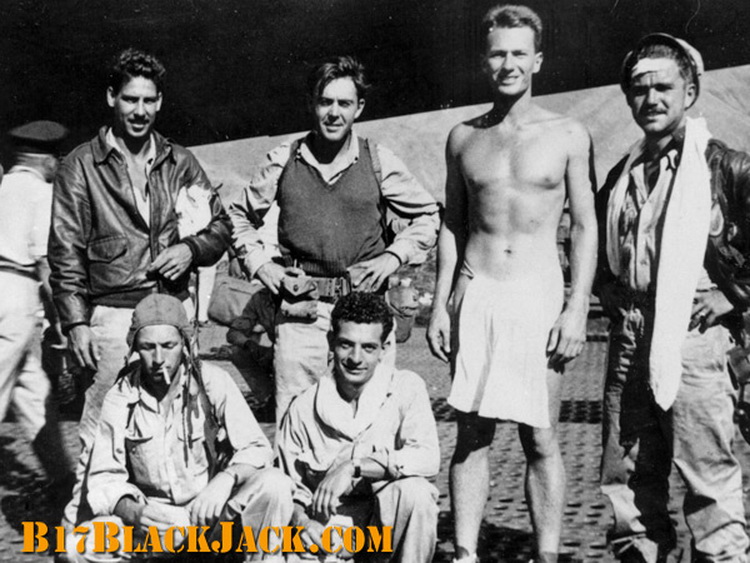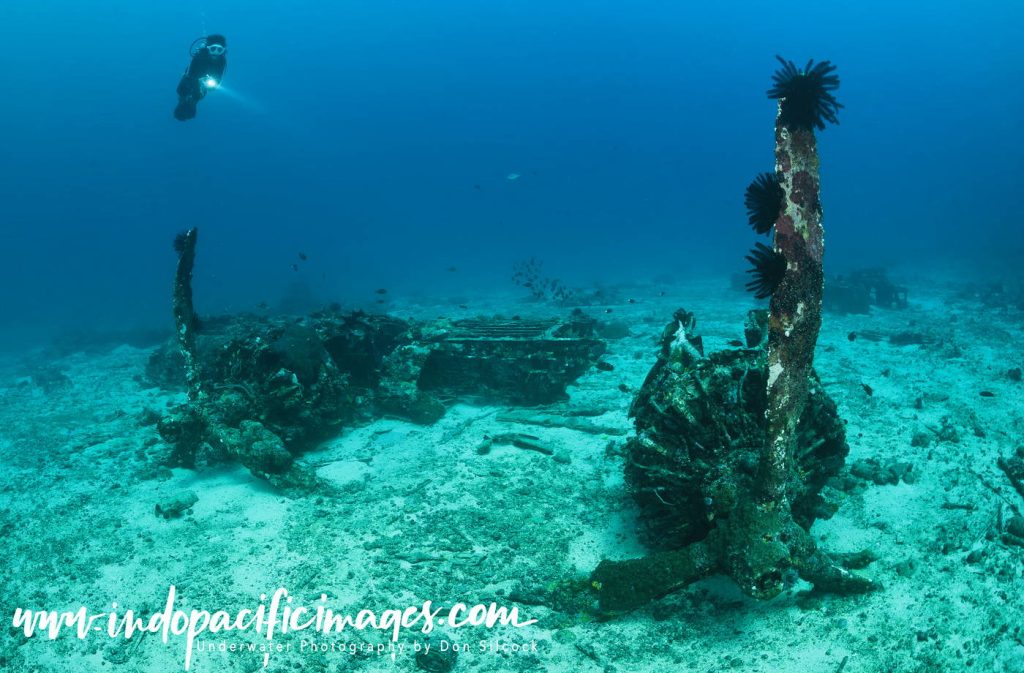The Best Aircraft Wreck Dives in PNG… World War II came to New Guinea in January 1942 when the Imperial Japanese Army invaded Rabaul in New Britain. Turning the region in to a major theater of war in the battle for the Pacific.
There were many brutal encounters between the Japanese and the defending Allied forces. Conditions were often appalling, and the fighting was incredibly fierce with many young lives lost on both sides. WWII was the first time that air power played a major role in combat. And both sides had some formidable aircraft in action during the campaign for New Guinea.
War is of course deadly by nature. But for the pilots and crew of those aircraft the rate of attrition was particularly high. Many of them were shot out of the sky. Others suffered mechanical failures while some just got lost and simply ran out of fuel.
The majority of those planes have never been found. Simply because they came down in remote jungle locations or far out to sea. But some have and the story of the underwater wrecks offer a unique insight into a time long gone.
Best Aircraft Wreck Dives in PNG – B17F Black Jack
Lying in deep water just off the fringing reef from Boga Boga village on the tip of Cape Vogel, is what many consider to be the best aircraft wreck in Papua New Guinea.


The wreck is the B-17F “Black Jack” Flying Fortress. Which takes its name from the last two digits of its serial number 41-24521…
21 is a “blackjack hand” in the card game of Pontoon.
Black Jack’s final flight was on the 10th July 1943 when it left 7-Mile Airdrome in Port Moresby.
Its mission was to bomb the very strategic and heavily fortified Japanese airfields at Rabaul in New Britain.
The flight was troubled from soon after take-off with two of the four engines developing problems.
However the pilot Ralph De Loach and his crew of nine, managed to reach Rabaul and deliver their bombs.
On the return journey Black Jack ran into a violent storm on approach to the coast of New Guinea.
A situation De Loach later described as “the blackest of black nights…the worst flying weather I’d ever seen in my life”.
Low on fuel and with two malfunctioning engines.
De Loach decided to head southeast towards Milne Bay, but was forced to ditch the plane at Boga Boga.
The crew survived the landing and scrambled out of Black Jack before it sank down to the sandy sea bed 50m below.
Where it lay undisturbed and largely unkown for another 43 years.


The Discovery of Black Jack
The discovery of Black Jack reads like an adventure novel…
With three Australians – Rod Pierce, Bruce Johnson & David Pennefather, stumbling on the wreck almost by accident in late December 1986. While actually searching for a completely different wreck!
The villagers had told Pennefather about a plane crashing near their reef in WWII. And he believed it might be the Australian Beaufort A9, which had crash-landed off Cape Vogel in November 1942.
Pierce, Johnson and Pennefather organized an exploration trip on Pierce’s liveaboard dive-boat MV Barbarian to search for the wreck.


Pearce found Black Jack as he made his way along the edge of the fringing reef at Boga Boga.
And, for someone who had dedicated his life to wreck diving, it was like finding the Holy Grail….
Over the next few days they dived the wreck as much as its depth of 50m would allow.
Entering the inside of the plane and finding the Radio Call Plate and 24521 serial number.
Which allowed them to identify the wreck as the Black Jack…

Diving the Black Jack
Diving the Black Jack is quite a unique experience as the plane is so intact and it is almost like a set from a Hollywood movie! The nose is badly crumpled from the impact of the landing and the propellers on the four engines are somewhat twisted. But the rest of the plane is all there and is quite remarkable sight after over 70 years underwater.
Check out the Complete Guide to the B-17F Black Jack Wreck for more information and dedicated articles on this amazing wreck.

Best Aircraft Wreck Dives in PNG – Kimbe Bay Zero
As the story is told around the bar at Walindi… The day the Zero was found by local villager William Nui, was not long after a small plane had crashed on take-off from Hoskins Airport in Kimbe Bay.
So, when William saw a plane laying on the sandy sea floor. He thought he had found the wreckage of the recent crash. Not that of a WWII Japanese fighter plane that had remained undisturbed for nearly 60 years!
William took his story to the local authorities. And word of the discovery made it to Max Benjamin at Walindi Plantation Dive Resort, who doubted the veracity felt that it should be checked out.

What Max found was a WWII Mitsubishi Zero in quite remarkable condition. There were no signs of bullet holes or combat damage to indicate it had been shot down. Rather the ‘off’ position on the throttle lever and the pitch control set to reduce air speed. Clearly pointing to a controlled crash landing.
The aircraft’s serial number and date were still visible on the wreck. And military records show that the plane went missing during the battle of Cape Gloucester on the 27th December 1943. The pilot on that day was Tomiharu Honda and local legend is that he was helped ashore by nearby villagers and guided back to Japanese held territory.

Diving the Mitsubishi Zero

Laying in just 17m of water the Zero wreck is easily dived, and bottom time is not a big issue.
Although its location close to the shore means that you need several dry days to see it at its best, as run-off can make the visibility fairly limited.
The total length of the fuselage is just less than 10m and the tip to tip wingspan is 12m, so it’s not a particularly big wreck.
The Zero is dived regularly by Walindi’s day boats and the resort’s liveaboard’s Febrina and Oceania also visit the wreck from time to time.
You can use the following link to read more about the discovery and the history of the Mitsubishi Zero Wreck.
Best Aircraft Wreck Dives in PNG – “Deep Pete”
While Rabaul was Japan’s main regional base. Kavieng in nearby New Ireland also played a significant role.
With the original Australian-built airfield expanded and a sea-plane base established.
Both of which became important targets for the Allied forces when the tide of war turned.
As a result there are more known aircraft wrecks around Kavieng than anywhere else in PNG and my personal favorite is the “Deep Pete”.


The plane is a Mitsubishi F1M floatplane. An aircraft that was designed and built to be launched by catapult from battleships, cruisers and aircraft tenders and used for reconnaissance missions.
The F1M was a biplane, with a single large central float and stabilizing floats at each end of the lower wing. Early versions suffered from poor directional stability in flight, and were prone to ‘porpoise’ when on the water. Which may explain why the wreck is actually there…

The name “Pete” comes from the way the Allied Forces identified enemy aircraft during WWII. As the actual Japanese naming convention was difficult to understand and pronounce. So, the Allies used code-names instead… With men’s names were given to fighter aircraft, women’s names to bombers and transport planes, bird names to gliders and tree names to trainer aircraft.
Diving the Deep Pete
The wreck of the Pete floatplane is located on the western side of Nusa Lik (small Nusa) Island. Which, along with Big Nusa Island provides the shelter for Kavieng’s harbor.
The wreck lies on its back, with the remains of its main float sticking up, on flat white sand in 40m of water. Hence the name “Deep Pete”… As it is on the Pacific Ocean side of Kavieng, diving it on an incoming tide, means that the visibility is often exceptional and usually in excess of 30m.
Although its tail is broken, its biplane shape is remarkably intact given the relatively lightweight and fragile nature of the aircraft. What makes the Deep Pete so photogenic is the resident school of yellow sweetlips that stream in and around the wings. Plus the batfish and barracuda that patrol in the clear blue waters above the wreck.
At just 31 feet long and with a wingspan of 36 feet Deep Pete is not a big wreck. But given its depth and the square profile of the dive, there is rarely enough time to fully explore it.
Deep Pete is dived regularly by the team at Lissenung Island Resort and you can use the following link to read more about the discovery and the history of the Deep Pete Wreck.


Best Aircraft Wreck Dives in PNG – Kavieng’s Catalina

The wreck of the Royal Australian Air Force (RAAF) PBY Catalina A24-11 lays in 20m near the entrance to Kavieng’s harbor.
The Catalina flying boat was developed by the US Navy in the 1930′s as a long-range patrol bomber. And, although slow and somewhat ungainly, they served with distinction during WWII. Both in the role they were designed for, and as a very effective way of rescuing downed airmen.
Their ability to land on water meant that they could be used to quickly and effectively rescue crews that had gone down in the Pacific and are credited with saving the lives of many Allied aircrews.
The Catalina Wreck
PBY A24-11 had taken off from Rabaul with 6 other RAAF Catalinas. They were on a mission to attack the Japanese base at Truk Lagoon. And had landed at Kavieng to refuel before heading north into the Pacific.
After refueling at Nusa Island, the Catalinas took off again one by one. But disaster struck A24-11 when one of its wing bombs exploded during take-off. The force of the explosion killed the crew instantly and sent what was left of the Catalina to the bottom of the harbor entrance, where it lay until 2000 when Rod Pierce found the wreckage.
The engines are what makes the Catalina wreck special as they stand proud on the seabed. Surrounded by those parts of the plane not obliterated in the explosion.

Whenever I have dived the Catalina my thoughts always return to the brave crew suspended in the flimsy fuselage below those massive engines. Like all the crews of the aircraft wrecks of Papua New Guinea, they were simply doing their duty to their country. Some lived to tell the tale. But many did not and those wrecks are poignant reminders of the sacrifices they made.
The Catalina is dived regularly by the team at Lissenung Island Resort. And you can use the following link to read more about the discovery and the history of the Catalina Wreck.

Air Nuigini Paradise Magazine Article
Paradise, the in-flight magazine of Air Nuigini recently published my article of mine on the Aircraft Wrecks of Papua New Guinea. And you can use the link to download the complete article.

